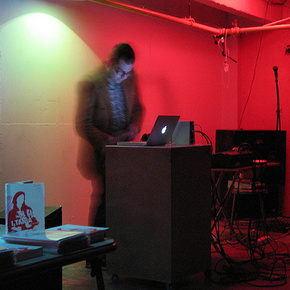
Team interview with Brian Joseph Davis & Steve Kado

Brian Joseph Davis does art and lives in Toronto. He has published a book with Coach House Books, Portable Altamont (2005), shown all kinds of art, made multiples and has done a number of different audio performances ranging from laptop DJing to synchronizing every song from Whitney Houston’s greatest hits using up to 10 CD players. Canvas Art Pictures also have some articles about his art. Davis recently issued a collection of his audio work, The Definitive Host (2007), on Toronto -based workers’ co-op the Blocks Recording Club. This is where I come in, having founded Blocks in 2003 and being the current president of said club. I’ve been in bands, toured all over the place and now mostly just confuse audiences with performances that I try to use as “real time social science” Davis has a new book that was published this September called I, Tania (ECW Press), a fictional account of the life of Patty Hearst, and is working on two new projects: one involves cheer squads and the other involves commercially available DVD menus with looping soundtrack samples. We spoke in the office of the Blocks Recording Club in late summer.
KEEPING IT REAL
BRIAN JOSEPH DAVIS: Let me ask you something. Have you ever seen footage of the press interviewing tape recordings?
STEVE KADO: Sorry?
BJD: Uh, if you look at archive footage of historical events–the two I’m thinking of are the Patty Hearst tapes and Howard Hughes saying his autobiography was a fake: both had press conferences where there was a reel-to-reel tape recorder with reporters holding microphones up to it. It’s the best thing in the world.
SK: Sounds like it is the best thing in the world. Photographic evidence of that practice must be amazing to view! It’s funny you mentioned that, because I was wondering why, after your last performance, you’d bother using 10 Discmen to perform the Greatest Hit (2005) [Brian had 10 Discmen open on a table, plugged into a variety of mixers and then into the PA system]. When Alvin Lucier does similar things, like I am sitting in a room (1970), it’s done as you described those taped press conferences: with a tape player playing the tape that Lucier made while he was “sitting in a room, different from the room you are in …” People just sit there for 45 minutes watching the reels turn on this tape player.
BJD: My first inclination to do it that way was because I thought I could make it really loud. And although I hate to use the term “chance operation” that element is there, too. When am I going to start each of the tracks?
SK: Okay, so why is it important to perform that chance operation publicly?
BJD: I think in practising the piece just to see if it was worthwhile, I fell in love with doing it more and more. It sounds slightly different each time I do it and I’m fascinated by that. Having done that 10 or 15 times at home, listening to how that Whitney track changed depending on the timing, which notes and rhythms came to the fore … there’s no conceptual thrust to it other than idiot glee.
SK: It sounds to me like you’re having a romantic reaction to “being a performer”; like other ways of doing this piece, such as prerecording it and just bringing it in for people to watch you turn it on, would be less “authentic” for you or something …
BJD: … and they look like cute little clams when they’re all open on the table.
SK: It’s weird that lots of the things that people like us are into, like Nation Of Ulysses and Crass, are very conservative and reactionary art. Crass were hippies a decade too late to be hippies. NOU are regressive modernists in a futurist mould, “destroy the past”–type modernists. Do you think that as honest fans of this stuff we’re actually forming the vanguard of a new neo-conservatism? Are we closet critical modernists? Is that retro?
BJD: I dunno, I always assumed po-mo was a stance. It wasn’t quantifiable. It’s just an approach.
SK: Well, how about this: we love work made with that modernist impulse to “make it new,” but by now that is almost a 100-year-old tradition. That, added to the fact that clearly, the romantic “authenticity” of doing the 10-Discman Greatest Hit work in a live context seems to sort of cancel out any po-mo irony that could be read into the project itself. We’re both either working with or have just worked on Adorno …
BJD: … you actually like Adorno way more than I do …
SK: Okay, but is there such a thing as playing if things are really happening? I’m saying we aren’t playing: we’re for real. Maybe it’s because of early involvement with punk rock, think of reading the MRR letters column about “What is punk?”
BJD: I can’t agree with you. Did you see that Johnny Ryan comic about the old-timey comic artists trying to out-old-timey each other? “I’ve got a 100-year-old bicycle and a top hat!”
SK: So it’s like Seth and Chris Ware …
BJD: Yeah, Seth and Chris Ware to the point of negation.
SK: See, I’d argue that the blank nostalgia for a period of time before your birth is ultimately postmodern. Seth and Chris Ware just use that stuff as a sadness-crutch because real tears are impossible for them. I’d argue that our desire to do the 10-channel audio installations for audiences as performance indicates a desire to assume authenticity that is lacking. The punk place where Johnny Ryan is calling these “old-timey” guys out from is a regressive, modernist place. You can’t believe that that failure to be authentic is risible if you’re not in some way invested in “keeping it real.” Take another example: the sudden appearance of “art metal” and weird, dumb art-world moves like the Met having an exhibit of Weimar-era art called Glitter and Doom. Art magazines reviewing records on Southern Lord, and shit like that: but does anyone read Kerrang! or Metal Hammer?
BJD: Being an interior designer to metal … how could that stuff exist without being ironic?
SK: Exactly: that’s why we both hold that weak trend in disdain. We simply cannot accept that something as important as metal can be a new curatorial prop for people who have no trouble with post-capitalism.
BJD: I was reading this book by Bunuel, where he says there’s a difference between profaning things and being a heretic. I just profane things; I’m not a heretic. I kind of agree with that.
TRASH
SK: If you went on vacation, read Proust for several months, didn’t watch Superbad (2007), saw no TV, read no People magazine, would that create anxiety for you? Would you worry that your work would be stalled without exposure to pop culture’s “garbage?”
BJD: That concern was there, but more before than now. The thing about art is that it has genius cooties. I’ll reiterate: genius cooties. You have to make, like, what it is you’re doing is so completely special, and that you are such a total unique genius for doing it. I want to approach my work as if it’s not special in any way at all. I’m only happy with the work when I know that it’s not particularly special. You said “garbage”–culture at large. Artists try to keep pace with it, but they just end up looking like idiots.
SK: Yeah, like all the terrible metal garbage again. There was this giant anarchy symbol on the programme at the Palais Des Tokyo this summer. Just embarrassing. So you don’t want to keep up with it: you just want to be in it. Immanent critique. But that said, there’s more to the world of culture than Jennifer Lopez. Why do you pick the stuff that you do? You could do Huysmans or something instead, no?
BJD: I don’t feel like I choose: there are vast cultural systems that choose for me. I feel like I’ve selected an even mix, but intuitively. So Will Ferrell and Guy Debord mean the same to me. I’m not trying to be crude, both those things are in the world as I came to it. I have to address that, my duty is to the world we are actually in. I’m not trying to be a boor. Some people have taken an anti-intellectual reading of my writing.
SK: No one’s going to confuse your music as anti-intellectual.
BJD: The music has fucked with what people think about me more than anything.
SK: Yet your works seem to be very similar to me. They come from the same urge.
BJD: The same uncontrollable urge. People think that by mixing these things I’m trying to destroy one with the other. I’m just interested in seeing what connects them, not what keeps them apart.
MEGA
SK: So speaking of that “urge”: I notice in so much of your work you tend to make big piles or chains of things. I’m thinking of Greatest Hit again, and also Voice Over (2005) on The Definitive Host, as well as lots of the Portable Altamont stuff, too. Let’s call this urge “the mega.”
BJD: I think what’s neat/sad about actual greatest hits collections is that it’s a dead technology. No one even knows about album tracks anymore: the entire Internet is a greatest hits collection, no more ponderous filler, just hits.
SK: It’s all on the iTunes playlist: only the hits have survived. Darwinian popularity.
BJD: The mega, as I do it, is just a mirror of processes already at work within this totality.
SK: Why mirror this process?
BJD: I’ve worked through several mediums, I’ve done other stuff, and this is all that I’m good at. My subtle OCD is another reason. There’s a certain kind of misery to this kind of work. Voice Over took a year of just sorting.
SK: This, I can believe.
BJD: And just in terms of how I live, that’s how I make my way through the world. I love collecting data and having it coalesce into some kind of structure.
SK: Which ties in to the earlier question of what would you do without trash? That’s the same procedure.
BJD: I am trash. You’re trash. The age of “I am different” is over.
SK: Hate to tie it back to Adorno, but seriously: immanent critique. Would you care to line up where the mega starts and ends for you? Lucier? Branca? Ligeti?
BJD: Glenn Branca was a definite inspiration, so was Lucier. I know how much you dislike Branca, but you must at least approve of his melding of metal (a folk-mega for sure!) and minimalism.
SK: I think you and Branca couldn’t be more different. What is key to your stacks, or chains, but more visible in the stacks (maybe because stacks are synchronic) is that the particular retains its particularity within the whole. It is precisely the differences that make things what they are. This is how Greatest Hit proceeds, for sure. Branca’s large guitar-army pieces eradicate that internal difference. They’re written for four different parts divided between large sections. He forms a fake totality out of all those guitars. Thus, it is fascist inside. No matter how discordant Branca’s gestures are, his model for combining sounds is fundamentally authoritarian and uncritical. He acts like he’s with the kids, but his compositional core is pure cop shit.
BJD: He was a real eye-opener for me in terms of my own understanding of what you can do, what you can get away with. Branca was vitally important, but I think you’re sacrificing the ambiguity to be experienced in his music. Plus, he once said, “David Byrne ruined art.” I like the idea that one person can ruin art.
SK: I will give you that conning hundreds of people into putting up with you being a baby is an amazing feat, and Branca should be congratulated. He has really pushed the boundary of “how much of me can a room full of you bear?” Maybe you can be tipped off by Branca, but you can’t actually be following his lead, because you have avoided those pitfalls. I’m viewing that as non-coincidental and, therefore, you are more punk. Maybe take it as a compliment? What else?
BJD: After Branca, for me, there was Ralph Ellison’s Invisible Man. The narrator, a music lover, has only one radio-phonograph, but plans to have five so that he can feel as well as hear his music. He imagines what it would feel like to have five recordings of Louis Armstrong’s “(What Did I Do to Be So) Black and Blue” playing simultaneously.
SK: Which is kind of funny, because as we know from Lucier, piling lots of the same things on top of each other in one room often just cancels sound out instead of making it louder. So where does mega end?
BJD: But the mega is volume–expressed spatially. It fills gaps in recordings. We’ve both been fucking up and using “volume” when we mean capacitance. I think mega ends in a few places for me. Some stabs at mega don’t work out: some Greatest Hit tracks weren’t hits; Britney Spears multi-tracked provided no punctum for me. But then there’s her recent MTV Awards show performance–which radiated torpor, boredom and rebellion. Mesmerizing. Whitney Houston multi-tracked brings me close to tears. Same with Voice Over. The other line is drawn when a source can/should be reworked in a different, more narrative way; and that’s the other aspect of my work. Translations and adaptations: Minima Moralia (2004), the 7-inch project; Eula (2007), the Sony BMG end-user licence agreement scored for choir; and the upcoming 13-Point Plan to Destroy America performed by a cheer squad.
OUR MOST PERFECT MIRROR
SK: You brought up in an earlier conversation how you thought it was amazing that although we accord the music industry so much importance within our culture, it accounts for less total revenue to the culture industry than breakfast cereals. But there’s definitely one thing we haven’t discussed at all, and I wonder if we’re even able to: video games. Since both of us have placed a high priority on our work acting on and being a part of the world as it is today, it’s amazing that neither of us have touched on, let alone worked with, the one part of the culture industry that is actually successful. Video games make more money than publishing, movies and music …
BJD: I think part of it for me is that I wouldn’t even know where to start making a video game. The amount of labour involved seems too baffling. I feel like anything that I can’t just attack on a DIY level is probably not for me. After all, I used 10 regular consumer Discmen, not 10 specially built sound machines or whatever. Not only that, but my video-gaming experience ended with SuperMario Bros. 3. After that point, I got involved in other things.
SK: Oh man, that is such an excellent Mario sequel. I think aesthetically I prefer Mario 2, but 3 is just so amazing and well worked out. You can really sense the extreme mastery that those video game programmers must have had on that project. But why do you think there’s no theory about this? After all, within a scant decade or two of movies moving from technological curiosity to mass cultural phenomenon, Walter Benjamin, et al., had come up with theories of cinema that are still in currency today: where is our Benjamin on video games?
BJD: I think part of it is that the level of involvement you need to play video games is just so much greater. You can go to a movie, sit through an hour or so of it, hate it and leave. But if within an hour of starting a video game, you’re not sure if it’s good or not, and you put it down. You’re still so new to the game world that you could be missing what would be really good about it. You don’t feel qualified to have an opinion.
SK: That’s so true. The other thing about video games is that the criticism that does exist is not really within the critical mainstream.
BJD: Yeah, because the involvement of the audience is so essential to the experience of the thing itself; the video game critic and video game audience are the same. The product space is coextensive.
SK: So the distance isn’t there to stand outside yourself with video games? We’re obviously not inside the video games, but at the same time we are. So maybe the conclusion we can draw about other media is that we can talk about them because they’re dead, or maybe in the case of movies always have been?
BJD: Video games are the perfect mirror of late capitalism!
SK: That’s awesome: I keep going on about immanent critique, and the coolest part is that they manage to represent everything about how we live without any mimesis …
BJD: … just Italian plumbers and dragons and fairies and shit.
SK: So I guess that means representational art is totally dead then?
BJD: Well, if we can talk about it … [high fives]



